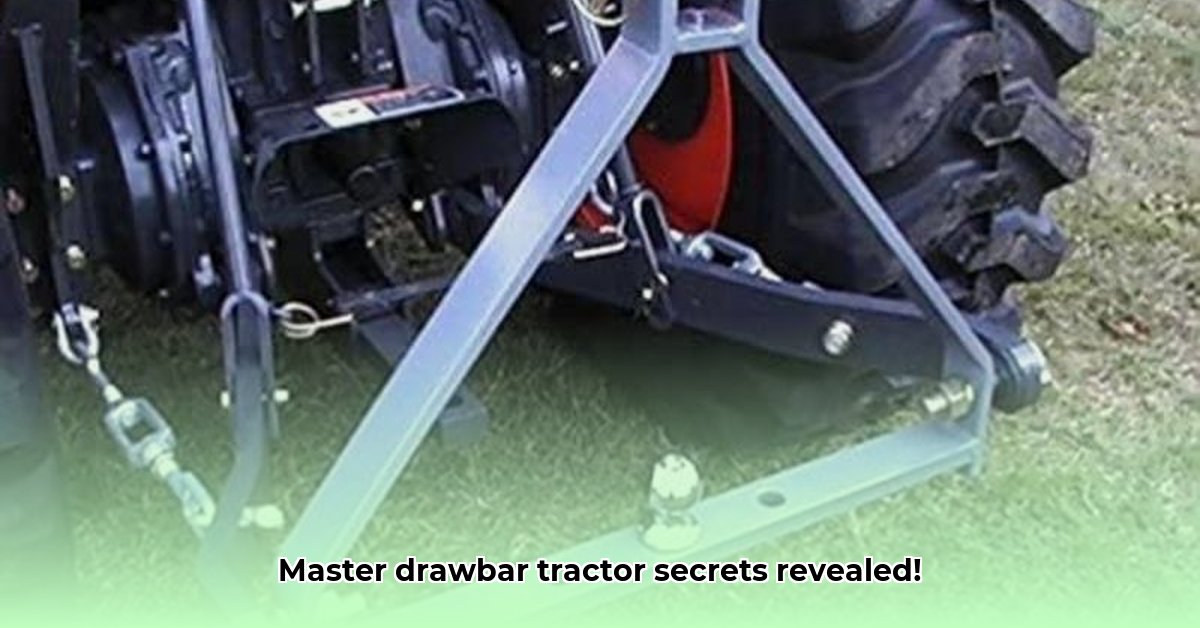
Choosing the Right Drawbar Hitch: Finding the Perfect Fit for Your Farm
Selecting the right drawbar hitch is crucial for efficient and sustainable farming. The wrong choice can lead to reduced efficiency, increased soil compaction, and even safety hazards. Several factors influence this critical decision. What type of implements will you be using? Heavy plows require stronger hitches than lighter cultivators. What's your soil like? Heavy clay necessitates a robust hitch to handle the stress, while lighter soil may allow for a simpler design. What's the scale of your operation? Large farms often need more durable, heavy-duty hitches than smaller ones. Let's explore your options: For more in-depth information, check out this helpful resource: Drawbar Hitch Guide.
Fixed Drawbars: These are simple, sturdy, and reliable, perfect for repetitive tasks like plowing straight fields. However, they lack flexibility; you're limited to straight-line operation.
Swinging Drawbars: Offering increased maneuverability, these hitches allow for easier turns and working around obstacles. They're more versatile but may necessitate slightly more operator skill.
Adjustable Drawbars: These provide the ultimate versatility, allowing precise adjustments for different implements and field conditions. They're the most adaptable but are generally more complex and costly.
A Step-by-Step Guide to Choosing Your Hitch:
Inventory Your Implements: List each tool used with your tractor to determine the required hitch strength and capacity.
Analyze Your Soil: Heavy clay soils, prone to compaction, demand a more robust hitch than lighter, sandier soils.
Consider Farm Scale: Larger operations may require more durable, higher-capacity hitches than smaller farms.
Establish a Budget: Higher-quality hitches, though pricier upfront, often provide longer lifespan, less maintenance, and superior performance, ultimately saving you money in the long run.
Prioritize Safety: Always select a hitch rated for at least the weight of your heaviest implement. Never compromise safety; underestimating capacity can lead to dangerous failures.
Mastering Drawbar Tractor Usage and Maintenance: Keeping Your Equipment Running Smoothly
Regular maintenance is vital; neglecting it invites costly breakdowns and safety hazards. Think of it as regular car maintenance—essential for optimal performance and longevity.
Pre-Use Checklist (Before Every Use):
Visual Inspection: Thoroughly examine the hitch for cracks, bends, or loose bolts. Look for any irregularities.
Pin and Lock Check: Ensure all pins are securely inserted, and locking mechanisms are engaged to prevent accidental disconnections.
Implement Alignment: Verify the implement’s correct connection and alignment with the tractor to prevent strain and ensure optimal performance.
Lubricate Moving Parts: A quick application of grease on moving parts reduces friction and extends the hitch's lifespan.
Regular Maintenance (Monthly or as Needed):
Bolt Tightening: Regularly tighten all bolts and connections to prevent loosening and potential failures.
Wear and Tear Checks: Inspect for wear and tear, focusing on areas under stress. Replace worn parts promptly.
Cleaning and Lubrication: Keep moving parts clean and lubricated to minimize friction and extend the hitch's lifespan.
Proper Storage: Store the hitch in a dry place, protected from the elements, to prevent corrosion and damage.
Sustainable Farming Practices with Your Drawbar Tractor: Working in Harmony with the Land
Sustainable farming involves protecting the land for future generations. Your drawbar plays a crucial role in this.
Minimizing Soil Compaction: Using the right hitch and techniques reduces compaction. Avoid overloading; select implements designed to minimize ground pressure. Excessive weight damages soil structure, lowering yields and water infiltration.
Optimizing Fuel Efficiency: Proper hitch selection and maintenance directly improve fuel efficiency. A well-maintained hitch reduces tractor strain, enhancing fuel economy.
Lifecycle Considerations: Choose durable, long-lasting hitches made from sustainable, recyclable materials to minimize environmental impact throughout the hitch's lifecycle. Consider manufacturing and disposal implications; select manufacturers committed to sustainable practices.
Comparing Drawbar Types: A Quick Overview
The ideal hitch depends on individual farming needs. Carefully weigh the pros and cons before choosing. Ongoing research may further refine our understanding; however, current knowledge suggests:
| Drawbar Type | Pros | Cons | Best Suited For |
|---|---|---|---|
| Fixed | Simple, robust, reliable, easy maintenance | Inflexible, limited maneuverability | Straight-line operations, repetitive tasks |
| Swinging | Increased maneuverability, versatile | Slightly more complex, potential for increased wear | Tasks requiring turns and maneuvering around obstacles |
| Adjustable | Maximum versatility, adaptable to various needs | More complex, expensive, requires more expertise | Diverse operations, varying field conditions, various implements |
Remember, sustainable farming is an ongoing process. Continuous learning and adaptation lead to greater efficiency, profitability, and environmental responsibility. Choose wisely, and your farm will thrive for years to come.